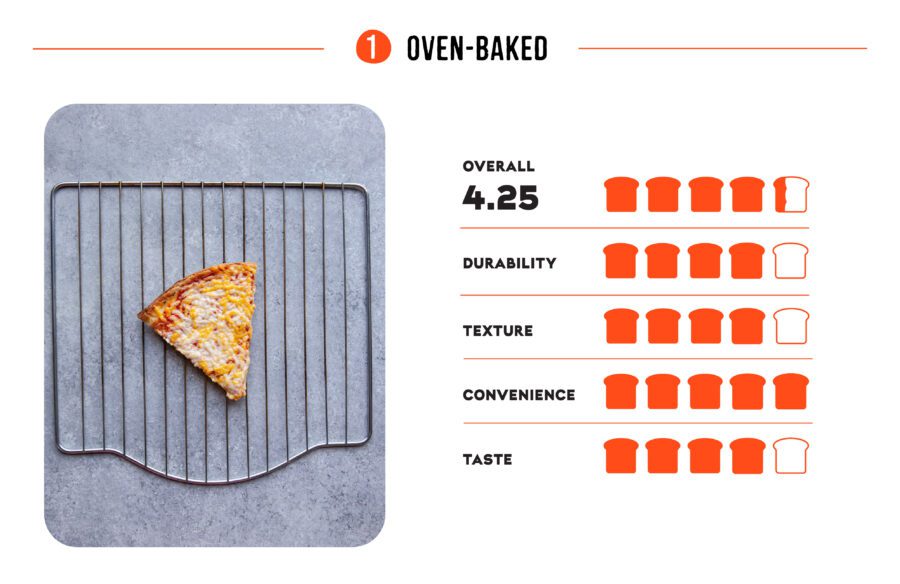Problem:
Too crunchy. Too soggy. Cold in the middle. Melt the roof of your mouth off molten. From disappointment to possible peril, reheating leftover gluten-free pizza is a challenge.
We want to know:
What is the best way to reheat gluten-free pizza so it tastes as good the next day as it did fresh from the oven (or the delivery box)?
Controls:
- Featured product: Little Northern Bakehouse Original Artisan Pizza Crust
- We used the Sprouted Oven GF 3 Cheese Pizza (because they make it on our Original Artisan Pizza Crust—and it comes in a box just like delivery. It’s just like our gluten-free Three Cheese Pizza recipe, so our test Kitchen covers delivery and bake-at-home pizza leftovers!)
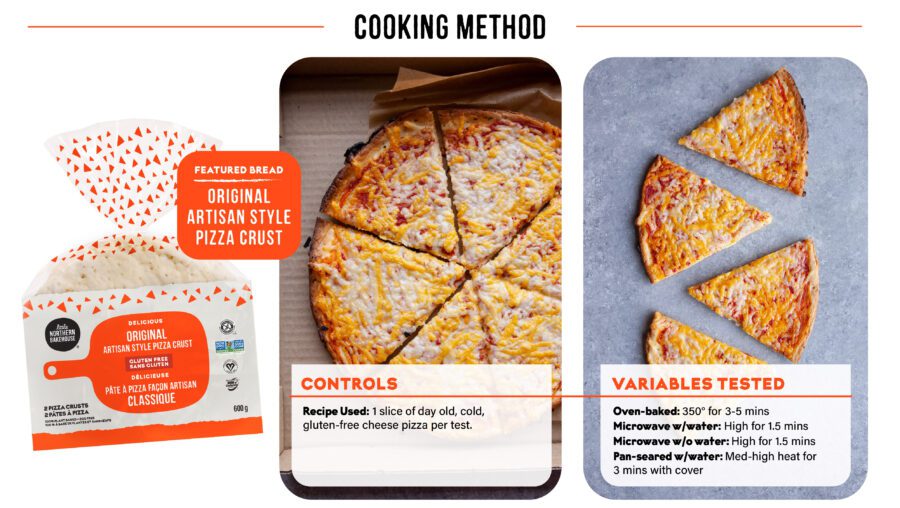
How We Scored Each Slice
To determine the best way to reheat gluten-free pizza, we tested four different cooking methods and rated them in four different categories:
- How the Crust Holds Up: Is it crunchy? Is it soggy? Or is it just right?
- Texture of the Toppings: Are they fresh and lightly crisped? Or are they soggy or rubbery?
- Convenience: What is the relative speed of the reheating method? How many dishes need to be washed? And how many pieces can be reheated at once?
- Taste: Does it taste like a fresh slice?
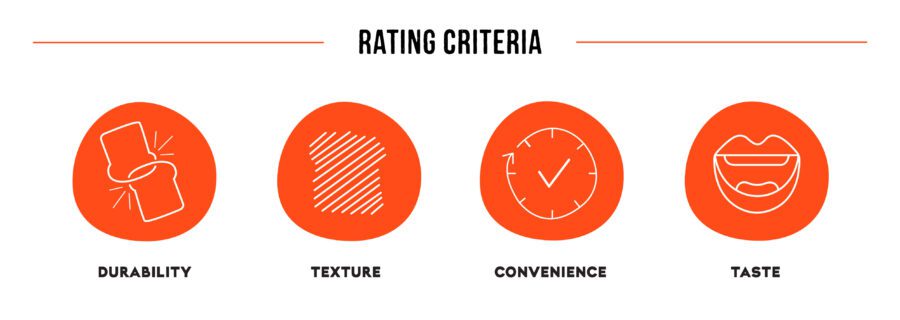
Oven-baked
Got a whole pizza to reheat? It’s worth turning the oven on! But if you’ve only got 1 or 2 slices to reheat for yourself, other options will get hot pizza in your hands faster than the time it takes to preheat your oven to 350℉. For more than half a pizza, the oven does a fantastic job of bringing warmth back to leftover slices while keeping all the textural goodness of a fresh from the oven (or delivery box) pie.
Just make sure not to overcook your pizza—the crust can get hard if you leave it too long. (To avoid overcooking, check the center of a slice with a fork after 3 minutes. If the tines are still cold, pop it back in for another 2 minutes, and repeat as needed. As soon as it comes out warm to the touch, your pizza is ready to eat!).
Pros:
- Crunchy, oven-baked texture.
Cons:
- Crust has potential to become too hard when baked for longer than needed to warm through.
Microwave with Water
One of the internet’s best tips for reheating pizza is to add a cup of water to the microwave with your leftover slice. This is supposed to divert moisture away from the pizza to keep the crust from getting soggy. It seems to work for wheat-based pizzas, but what about gluten-free? Let’s see if this reheating hack is all hot air.
Reheating pizza in the microwave is fine when you’re strapped for time—but that’s about it. In our test, the taste was okay, but the texture was way off. The crust was chewy and rubbery and not fun to eat. Simply put, we were not the biggest fans of this cooking method.
This result may be due to how we used our microwave. Microwave times and power settings can vary depending on your make and model, so it’s always a good idea to test yours by reheating your pizza in 30 second increments. Experiment with different settings until you find the perfect method for microwaving that works for your appliance. Sometimes one minute on 50% power can do a better job than 30 seconds on high—these settings can make a huge difference!
Pros:
- Cheesy taste was brought back to life—it really stood out!
Cons:
- Texture of crust was chewy and rubbery.
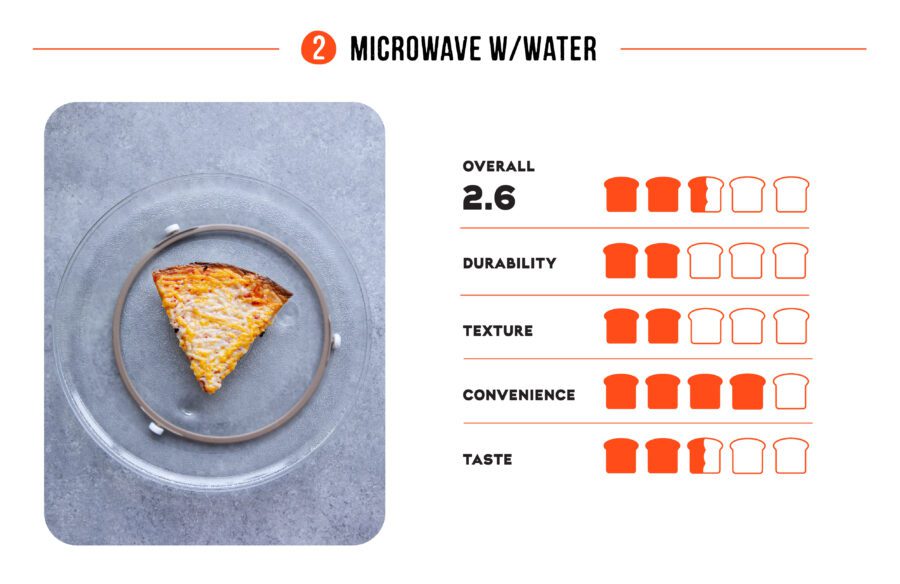
Microwave
Surprisingly, reheating a gluten-free pizza in the microwave turns out pretty much the same whether you add a cup of water or don’t. We’ve heard the water trick makes a big difference with wheat-based crust pizzas, but our tests showed it has no benefit for gluten-free slices. If anything, this version of the microwave method is easier because you don’t have to add a cup of water to the microwave too.
Pros:
- Similar method, similar result. The cheesy taste really stands out in the microwave.
Cons:
- Crust became rubbery and quite chewy.
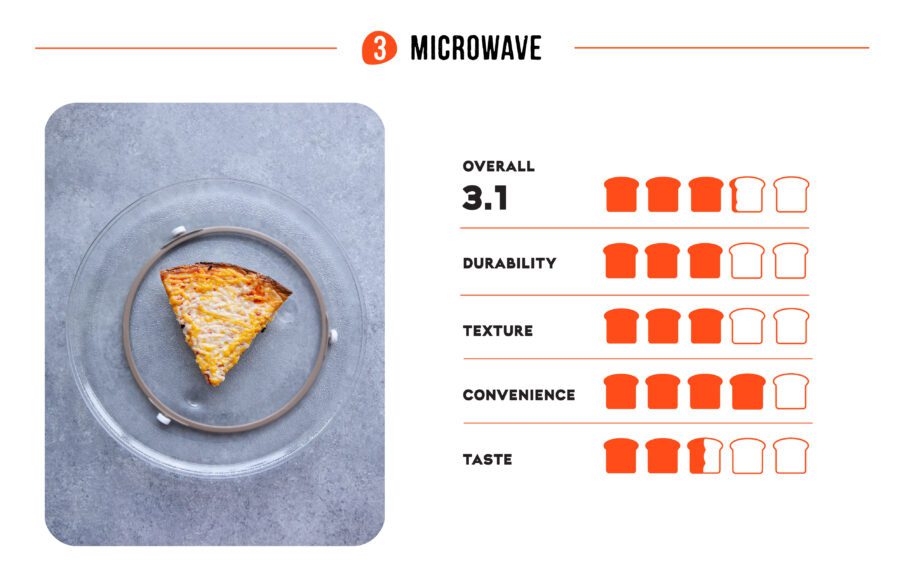
Pan-seared (with water)
Searing the pizza in a pan adds a hint of toasty flavour to the bottom of the crust. But only reheating your leftover slices from the bottom up won’t re-melt your cheese—a splash of water and a lid takes this method to the top of the gluten-free pizza reheating podium.
Unsurprisingly, the method that requires a little more attention and care is the one that produced the best result of all our tests. But don’t worry. Although it’s more involved than punching buttons on the microwave, this method of reheating gluten-free pizza is super easy! Simply fry your pizza on medium-high heat for about 2 minutes, then add a tablespoon of water to the pan and continue frying for another 1 to 2 minutes. (Cover the pan during the steaming phase for a best results—the steam helps melt the cheese and enhances the flavour of the sauce and toppings, too!).
Depending on the size of your pan (and your pizza), this method works for 4 to 8 slices at time.
Pros:
- Maintained that crunchy crust we crave, and the cheesy topping was soft and gooey.
Cons:
- Not a single con to be found!
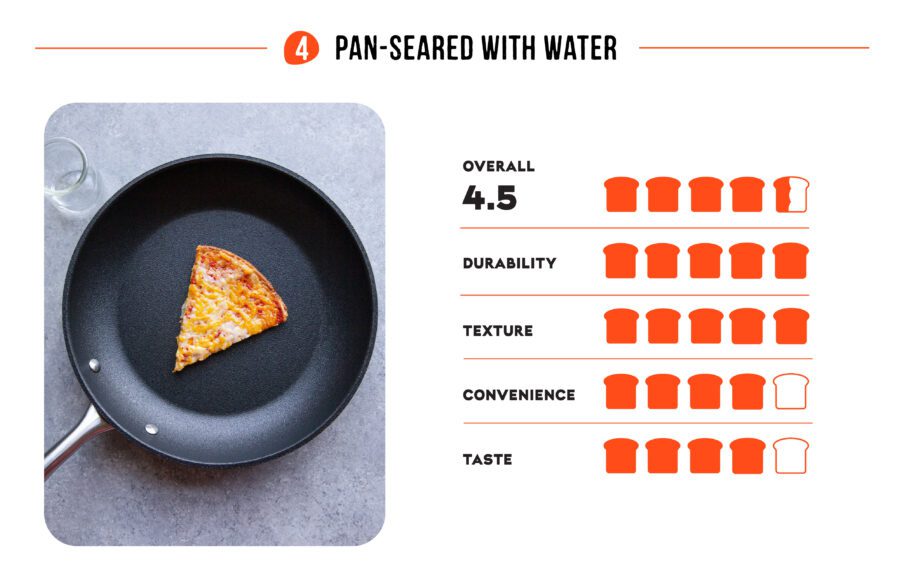

Unless your kitchen is equipped like a pizzeria, reheating gluten-free pizza to fresh from the oven perfection is no small feat. But after our tests, we can confidently say frying and steaming your slice in a skillet is the best method going. It makes for a perfectly crunchy crust, warm toppings, melty cheese, and an overall tender, flavourful slice! Taking a little extra time and care to reheat your pizza goes a long way! (But the microwave is always there when fast and easy is all you have time for).
For more gluten-free resources, sign up for our monthly newsletter at the bottom of this page. Check out our other gluten-free test kitchens for helpful tips, and follow us on Facebook, Instagram, and Pinterest for more gluten-free content.
